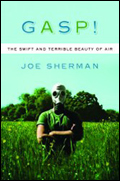
Gasp! by Joe Sherman,
Shoemaker & Hoard,
417 pgs., 2004.
Oxygen may not strike you as a likely protagonist for a book. It’s invisible, it’s all around you, it’s something you inhale 19,000 times a day and take utterly for granted. But Joe Sherman’s Gasp! The Swift and Terrible Beauty of Air is a masterfully inventive biography of air, weaving together geology and history, myth and science, to deepen our understanding and appreciation of life’s most precious gas.
“Understanding air, which is both big and amorphous, and small and right in front of you, demands a few mental oscillations,” Sherman writes. One place to start is in the realm of myth, where stories about the sky are as old as civilization. From India to Egypt, from the Vikings to the Amazonian natives, early human societies forged legends about the invisible gas that surrounded and sustained them. Gods of the sky, like the Greek god Zeus and the Norse god Thor, were frequently violent, short-tempered characters whose actions mirrored the air’s extremes with “torrential storms, raging winds, fire-spewing lightning bolts with blasts of thunder.”
In the modern world, however, “the intensity our forebears felt as they stared upward in a state of wonder at the sky” has been largely lost. Sherman wants to remind us that air does not belong exclusively to the realm of science, that “the sky is a place and it has been since time immemorial.” It is with hope for humanity’s renewal of a more primitive, mystical connection with the sky that he writes, “Myth came before science and will outlast it.”
Sherman devotes a significant portion of his book to the fascinating and obscure history of air science, starting with the Ionian philosophers of ancient Greece. The great minds of the time all had something to say about air: Anaximenes and Heraclitus insisted it was fundamental to the chaotic, chemical mixture of the planet; Plato called the ether beyond air the “nurse of generation” from which sprang fire, earth, and water; Aristotle posited a theory of air as “exhalations” rising out of the earth. When trapped underground, he wrote, these exhalations created metals like copper, gold, and iron; released into the atmosphere, they became the very air we breathed.
Through short, compelling biographies, Sherman brings to life the philosophers, chemists, biologists, and inventors — many of them largely forgotten, despite their genius — who advanced air science through the ages. One is the wandering 16th century homeopathic doctor Paracelsus, who enraged the Catholic Church and Europe’s medical establishment by claiming that certain sicknesses (among mountain miners, for example) resulted from foreign particles traveling through the air and entering the body. Though recognized today as one of the founders of modern medicine, Paracelsus, like many scientists in pre-Enlightenment Europe, threatened the Church’s notion of an earth-centered universe created by God. By analyzing the makeup of the air (and at the same time mocking popular treatments like bloodletting with leeches and urine inspection — “All they do is gaze at piss,” he said), Paracelsus crossed a forbidden line, one we might credit as a proto-environmentalist understanding of the “natural magic” that is our atmosphere.
Sherman describes other, more familiar characters as well, such as the Renaissance-era Robert Boyle, “an upper-crust, God-fearing Englishman, the first scientist to experiment extensively with air,” and his partner Robert Hooke, who together measured air’s ability to compress and expand, showing that the volume of a gas varies inversely with pressure — a theory that became known as Boyle’s law. While Boyle left behind dense and numerous writings about air, Sherman praises Hooke’s single published work, Micrographia, which, as “a veritable bouquet of scientific insight and observation from a shriveled, odd little genius, remains a genuine masterpiece.”
Later, eccentric British chemists like Thomas Hales and John Mayow tinkered at odd experiments (such as wearing masks cluttered with valves and tubes to see how long one could inhale one’s own breath before passing out) and proposed equally odd theories (such as the notion that respiration brought fine nitrous particles into the body, which then fermented in the blood and “fired” the heart). In 1700, George Stahl invented a wacky theory about a substance he called phlogiston, which he said was contained in materials like wood and set free through combustion. Flames, Stahl said, were the visible signs of the invisible phlogiston at work — a notion “so persuasive that it stalled advances on other theories of combustion and respiration for most of the century.” Later in the 1700s, John Dalton built barometers, rain gauges, and thermometers, and pushed atomic theory one significant step forward by discovering the law of partial pressures, which states that the atoms of mixed gases distribute themselves evenly among one another.

There’s something in the air …
The French also contributed to atmospheric science, especially in challenging the restrictive barriers of the Church. Notably, the philosopher Blaise Pascal spent his early years lugging a mercury barometer up and down stairs and finally to a mountaintop, where he proved that the weight of air decreased with altitude. “Making the assumption that air would continue to weigh less and less the higher one went, Pascal decided that eventually air must not weigh anything at all,” Sherman writes. “If air became weightless, it must become nothing. And nothingness was a vacuum. It was the void. At issue, of course, were not the properties of air but the authority of the Church. At issue was atheism.” The idea that the air and the sky stopped existing entirely — that if humans could look high enough they would see nothing overhead, neither light nor oxygen nor even God — went against the belief in a divine cosmos created for humans. (In Pascal’s philosophic view, God may have indeed created the earth and the heavens, but he’d abandoned his creation and left it to humanity to figure out.)
It wasn’t only theological risks that scientists took in positing an “end to the atmosphere.” The French chemist Antoine Lavoisier, credited with discovering oxygen, was beheaded during the Reign of Terror. In the 19th century, other chemists braved that “mainstay of atmospheric research,” hot-air balloon flights. In 1862, Henry Coxwell and James Glaisher ascended 35,000 feet into the stratosphere, where they fought off cold, unconsciousness, and a new thing called altitude sickness, all of which made the task of recording air samples a whole lot more rugged. The air chemists became not “explorers of the seas, like Sir Francis Drake, or of the stars, like Johannes Kepler, but of the invisible.”
Hold Your Breath
Alongside the story of air science, Sherman weaves the evolutionary history of air itself. In doing so, he demonstrates a talent for explaining big ideas in simple, lay terms, from the Big Bang and the formation of oxygen in the earth’s atmosphere to the Cambrian explosion a half billion years ago, when vegetation boosted oxygen to the levels it remains at today and enabled life to flourish on land. He not only makes air exciting to read about but also conveys the great and unlikely fortune that brought evolution to our doorstep, allowing us to live and breathe the way we do.
Sherman wants humans to appreciate that fortune before it’s too late, and so he dedicates the third and final section of Gasp! — which he subtitles “Hold Your Breath” — to a harrowing review of air pollution as it started in England during the industrial era and continued through the last 100 or so years in the United States. One early form of pollution came from warfare: the mustard and poison gases that were introduced in World War I, and the biological and nuclear weapons testing that followed. But the most devastating impact came from industry emissions and, as anyone who reads this magazine will know, from that most beloved member of the American family: the automobile.
As a former resident of Los Angeles and author of the Pulitzer Prize-nominated book about General Motors, In the Rings of Saturn, Sherman makes no effort to disguise his disdain for car culture and its adverse effects on the environment. Between 1920 and 1950, smog replaced smoke as the country’s main air concern. On July 26, 1943, a day when no one could see farther than three city blocks in Los Angeles, smog was officially recognized as a problem in that city. Later, the “autopsies of people who had breathed L.A.’s air for decades revealed rib-like bands of soot wrapping once-pink lungs, with black splotches of carbon here and there.” But that didn’t stop the country from paving 43,000 miles of highway over the next 50 years, Sherman notes.
The first federal effort to protect the air was the 1963 Clean Air Act, signed into law by John F. Kennedy. Lyndon Johnson’s Federal Air Quality Act followed four years later, encouraging more auto emissions standards. The most substantial developments, however, happened under the Nixon administration, with the establishment in 1970 of the Air Pollution Control Office, a branch in the newly created Environmental Protection Agency.
Still, by the late 1980s, more than 300 urban and rural areas still failed to meet federal clean-air standards for ozone alone. Terms like smog, acid rain, hazardous chemicals, and radioactive waste became political buzzwords, and environmental concern in Congress grew strong enough to stop Ronald Reagan from dismantling the Clean Air Act. Now, with President Bush entering a second term in office, it’s fair to expect that, in regards to pollution, the sky will, in fact, not be the limit.
That should have all of us worried, but recently, our fears about air have mostly been fears about things that are airborne: anthrax, SARS, hijacked airplanes. As Sherman makes ominously clear, “The new era of terrorism, with its heightened focus on the particular event, could be put into sound bites, easily grasped, and disseminated as news while the general and pervasive air pollutants got pushed aside.” Half a million people still die each year from air pollution worldwide, yet thanks to the Bush war hawks and an obedient media, “air terrors now threatened to obscure the real health culprits of the sky.”
And yet Sherman sees room for hope, in the individual and collective conscience. If he has a message for his readers, it is that each of us must be responsible for our own breath, the personal air that we take in and give out to the world. We must study it, free it, and recognize it as the essence of all living beings, a heritage of shared molecules that goes back to the Big Bang. We must, as he puts it, “pay a little more attention to the daily 19,000, I often tell myself. Appreciate the air, this mystical and scientific elixir, whatever its condition.”



